An innovative eDNA study supported by SFI examines streams after massive wildfires in Oregon.
Steve Wilent
The Labor Day 2020 fires in western Oregon were unprecedented not only in the area burned—more than one million acres—but also in their ferocity. Hot, dry east winds swept across the state, causing small fires to rapidly explode into megafires of 100,000 acres or more within hours. In addition to five megafires, 12 other fires either started or expanded rapidly on September 7 and 8, 2020. These fires destroyed more than 6,000 homes, businesses, and structures. They also killed or damaged trees that could have produced an estimated 15 billion board feet of lumber.
Although deemed catastrophic in many respects, the wildfires offered scientists an unparalleled opportunity to study the impacts on streams and fish. Forests contribute woody material to stream through woody material and shade provisioning that can positively contribute to aquatic habitats for many species. A team of scientists from the National Council for Air and Stream Improvement (NCASI), Weyerhaeuser, and the US Forest Service Pacific Northwest Research Station set out to examine the impacts of wildfire on riparian-zone vegetation and aquatic biodiversity.
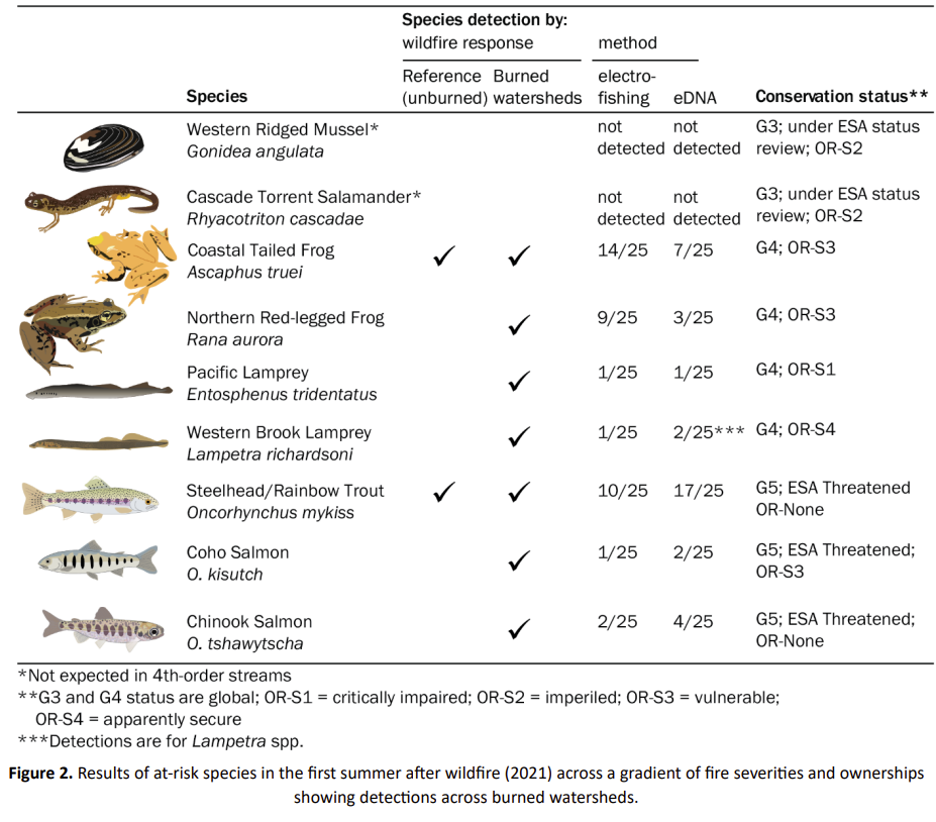
A conservation grant from the Sustainable Forestry Initiative (SFI) supported the initiative by funding the analysis of environmental DNA, or eDNA, collected from streams in three of the largest wildfires. This DNA is from fish, macroinvertebrates, plants, and other organisms and collected from samples of soil, water, or air. This genetic information comes from the shedding of cells from skin and scales, waste material, spores and pollens, and decomposition. The study is the first to employ eDNA to assess aquatic biodiversity within such large areas burned by wildfires, an important area of study for the decade-long SFI Conservation Impact Project, which strives to measure conservation outcomes of forest certification. Additionally, SFI is the only forest certification standard requiring certified organizations to support forest and conservation research.
For the study, researchers used stratified random sampling to select 30 stream reaches in watersheds burned in three of the largest of the 2020 fires (Riverside, Beachie Creek, and Holiday Farm) with a range of pre-fire stand age and fire severity, including unburned watersheds and those that experienced high-severity fire. Six additional unburned watersheds in Washington State are also serving as control sites during the five-year study.
Nearly half of the lands burned in 2020 were federal, mostly USDA Forest Service and Bureau of Land Management; the remainder were in private ownership (44 percent) and state and other lands. Roughly 125,000 acres of Weyerhaeuser timberlands certified to the SFI Forest Management Standard in Oregon were burned. The fires also burned significant areas of other SFI-certified timberlands, including 8,000 acres owned by the US Forestry division of Port Blakely.
“We thought that the effects of wildfires on aquatic ecosystems would be the physical responses more than anything, such as canopy cover and the amount of light reaching the stream channel,” said Dr. Ashley Coble, Senior Research Scientist with NCASI. “We also thought fires would eventually, if not immediately, have huge effects on large woody debris entering stream channels. This would have a significant impact on the amount of sediment moving through and/or being stored in these stream systems. We expected that these and other factors will influence aquatic food webs, whether that’s primary production within streams or secondary production of macroinvertebrates, which are part of the food web but are also good indicators of water quality, indicators that are commonly used by regulatory agencies in assessing water quality.”
During the study, Dr. Jake Verschuyl, Director of Western Forest Sustainability at NCASI, focused on wood in streams in areas with varying levels of forest management, including areas where salvage harvesting operations were conducted soon after the fires were controlled. A certain level of woody debris in riparian ecosystems can contribute significantly to aquatic habitat complexity and ecological function.
“We assumed that fire severity would have an effect on the input of wood into the streams and we wanted to look at how forest management in these watersheds might also affect that input,” said Verschuyl. “So far, we haven’t seen much of a signal that forest-management intensity is driving wood into the streams when compared to wildfire severity. That’s not too surprising, but I expect the dynamic of wood entering streams to shift a bit over time. As we continue to study these watersheds, we’ll be better able to describe the full dynamic. We’re only now beginning to see the early stages of this input from the various disturbances that occurred along those streams and how it effects aquatic habitat.”
While wildfire severity is a much stronger factor in wood inputs into streams than is timber harvest intensity, opportunities may exist for the placement of woody debris into streams during harvest operations, when machinery is present and available to move logs into place to improve aquatic habitats. The SFI Conservation Grant that supported the project helped researchers analyze eDNA to assess the effects of the fires on these aquatic ecosystems. In this case, fragments of eDNA from a cutthroat trout in stream water, for example, confirm that fish are present in the stream.
Fragments of DNA shed from fish typically come from scales or excrement. Dr. Brooke Penaluna, a Research Fish Biologist with the US Forest Service, shared how these fragments act as breadcrumbs that indicate the presence or absence of a species, its relative abundance, and genetic variability within the species. A variety of devices for filtering DNA from water samples in the field are available. Penaluna and her colleagues use a device called a Tube for eDNA (ToD), made by David Leer of CreekWalker Aquatics, that allows them to process up to four samples from one location. The ToD has separate filters for each of the four samples, which are then sent to a lab for DNA analysis.
Care must be taken to avoid contaminating samples. Scientists wearing clean waders and surgical gloves to collect water samples from a targeted area of a stream, river, pond, or wetland. In streams and rivers, scientists collect water from upstream of their position to avoid contaminating a sample with DNA that may be on their gloves, waders, or clothing. In summer, when stream flows are low, fragments of DNA may travel 50 meters or less before settling into sediments at the bottom. In fast-flowing rivers, the fragments may travel as far as several kilometers. DNA fragments deteriorate over time; they do so faster in water with high pH levels or relatively high temperatures.
Another researcher involved in the study, Dr. Laura Six, a Forest Ecologist at Weyerhaeuser, who focuses on biodiversity research and sensitive species monitoring in managed forests. For the past four years, Laura has served as Weyerhaeuser’s representative for Project Learning Tree (an educational initiative of SFI), a national environmental education, forest literacy, and green jobs program designed for educators, parents, and community leaders helping children from preschool through 12th grade learn about trees and nature, with career supports for early professionals.
“It’s interesting to see from our data that the response after wildfire is very dependent on the layer of vegetation,” Six said. “For instance, the mortality of the tree canopy often doesn’t happen all at once—we’re still seeing mortality three to four years after the fire. But the understory has seemed to respond a lot more quickly, at least in terms of cover and species richness. A year or two after a fire, it looks similar to unburned sites. Species composition might be a bit different, as in the vegetation community may be a little different, but the overall cover in the number of species there is similar within a year or two.”
Although the study is not yet complete, the findings so far also indicate that fish in the study area are resilient to wildfire. Penaluna and her colleagues will be making observations and collecting data through the summer of 2025.
“Some people were thinking that these large fires would be very detrimental to aquatic ecosystems,” Penaluna said, “but our findings so far are surprising because we’re finding that most of the responses show that fish are quite resilient to wildfire—either there was no response or they’ve recovered. Amphibian tadpoles have shown greater sensitivity, but for most of the organisms in the streams the general story is that the impacts of wildfire haven’t been as detrimental as anticipated.”
“Now, the question is how frequently we need to sample after 2025,” she said. “Can we sample every two or three years and get a sense of whether the first five years were the most important years? And, of course, we’re waiting for a big storm event to come in, so we can begin to understand its impact on the post-fire environment.”
To further promote and communicate the research, the Oregon Forest Resources Institute organized a field tour with support from NCASI, Weyerhaeuser, and other partners in summer 2024. It was held along the Middle Fork of the Molalla River, southeast of Portland, Oregon. The tour showcased three project field sites, demonstrating differences in fire impact, management responses, and the resilience of aquatic ecosystems and riparian vegetation through eDNA analysis and field observations.
Increased fire resilience for forests and communities, as well as greater forest health and enhanced climate adaptation and mitigation are key long-term objectives identified in the new SFI 2025-2030 Strategic Direction, and the SFI Forest Management Standard includes objectives related to Climate Smart Forestry (Objective 9, requiring SFI-certified organizations to develop adaptation strategies to climate change risks and to mitigate the effects of their operations on climate change) and Fire Resilience and Awareness (Objective 10, requiring SFI-certified organizations to limit the adverse consequences of wildfire on water quality, quantity, and biota).
The project will inform forestry practices and enhance understanding of eDNA sampling to assess biodiversity outcomes and inform forest management. As the study progresses, SFI will elevate the results with regional SFI Implementation Committees (SIC) and in conservation programming to support SFI-certified organizations.
Steve Wilent is an independent forester, educator, and journalist who lives in Zigzag, Oregon. Contact him at SWilent@gmail.com. A version of this article was published in The Forestry Source, a publication of The Society of American Foresters, September 2024, eforester.org.© 2024 The Society of American Foresters.
Additional Information
- SFI Conservation Grant Program: forests.org/conservationgrants
- Coble, A. A., Penaluna, B. E., Six, L. J., & Verschuyl, J. (2023). “Fire severity influences large wood and stream ecosystem responses in western Oregon watersheds.” Fire Ecology, 19(1), 1-21. Open access.
- Kirkland, J. & Penaluna, B. E. (2023). “The promise of environmental DNA: Life in northwest streams revealed through a bottle of water.” Science Findings, US Forest Service Pacific Northwest Research Station.
- Penaluna, B.E., Coble, A. A., & Ellison, A. (2024). “Effects of fire on stream ecosystem responses in western Oregon watersheds.” Northwest Fire Science Consortium Research Brief.
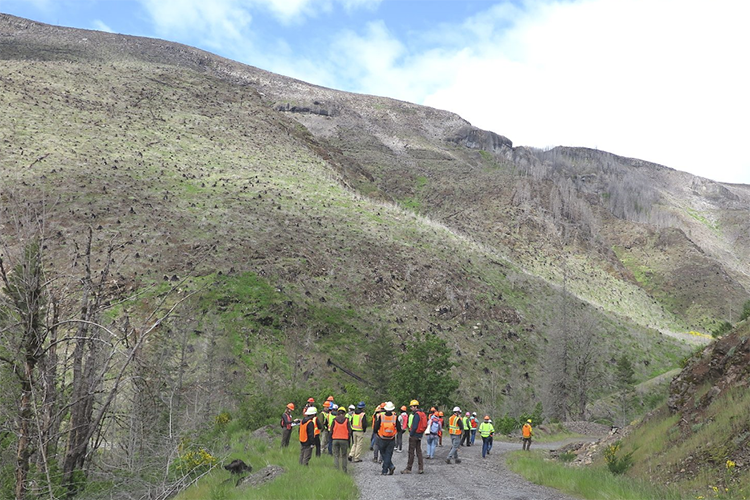
A burned and salvaged area on Weyerhaeuser land burned in 2020. Photo by Steve Wilent.
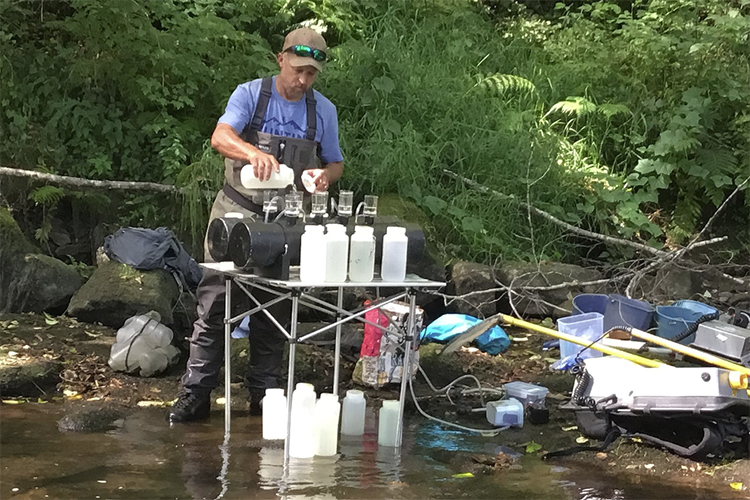
Dave Leer of CreekWalker Aquatics, a lead contractor for NCASI, collects DNA samples from an Oregon stream. Photo courtesy of NCASI.
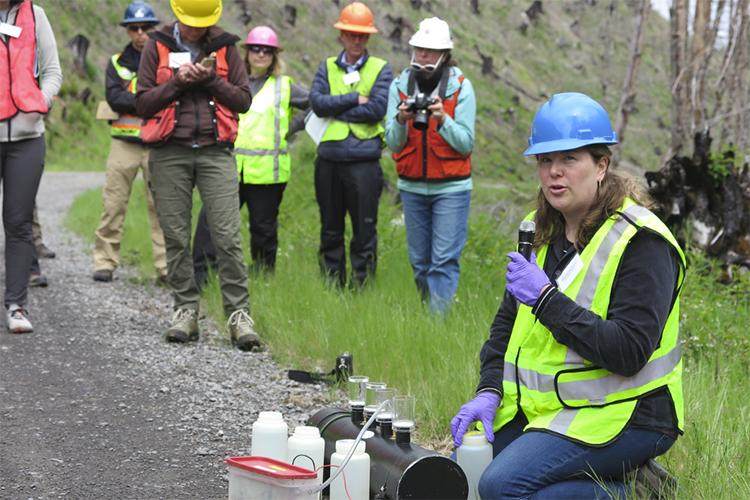
Brooke Penaluna, a Research Fish Biologist with US Forest Service, demonstrates processing an water samples from a stream on Weyerhaeuser land in Oregon. Filters from the device will be sent to a lab for eDNA analysis. Penaluna explained the process during a tour of the area organized by the Oregon Forest Resources Institute in May. Photo by Steve Wilent.
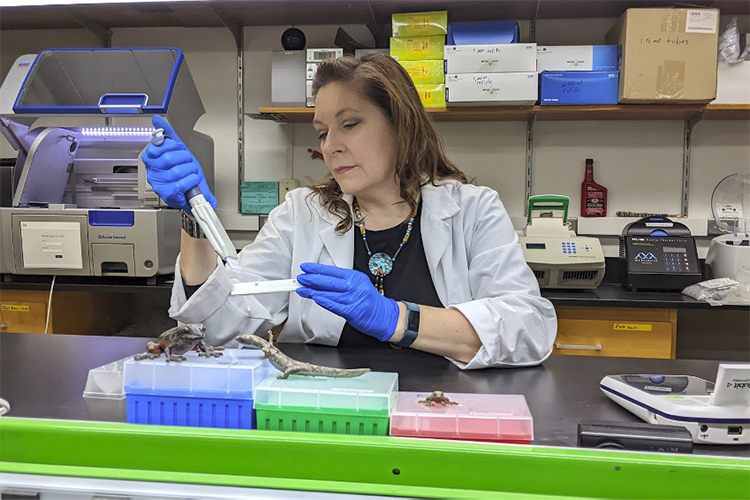
Laura Hauck, a biological science technician with the Pacific Northwest Research Station, works with eDNA samples in the Corvallis Forestry Sciences Laboratory. Photo by Rich Cronn, USDA Forest Service.
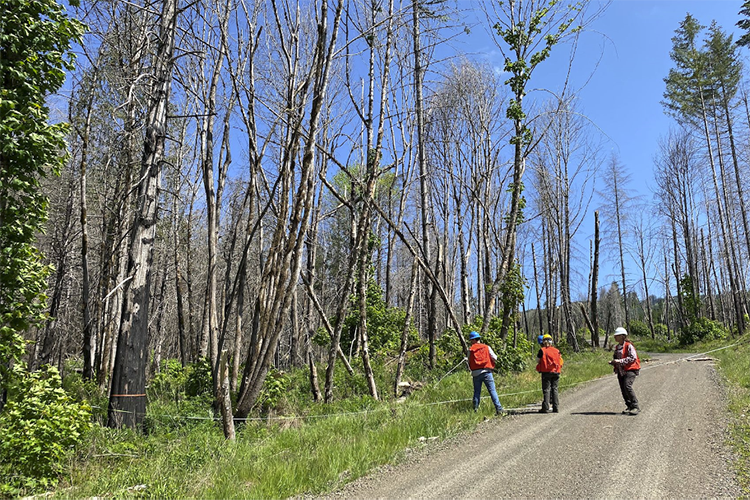
Researchers collect data about dead and downed trees along a stream in an area burned by a 2020 wildfire. Photo by Laura Six.
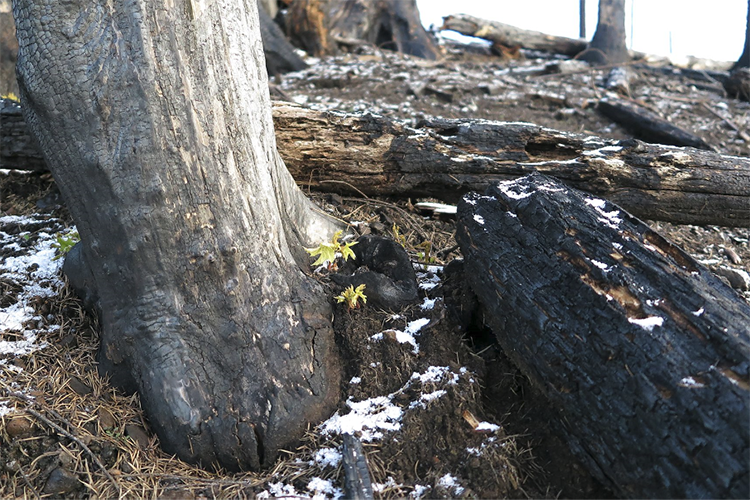
Six months after a 2020 wildfire in Oregon, bigleaf maples like this one showed signs of life. Photo by Steve Wilent.
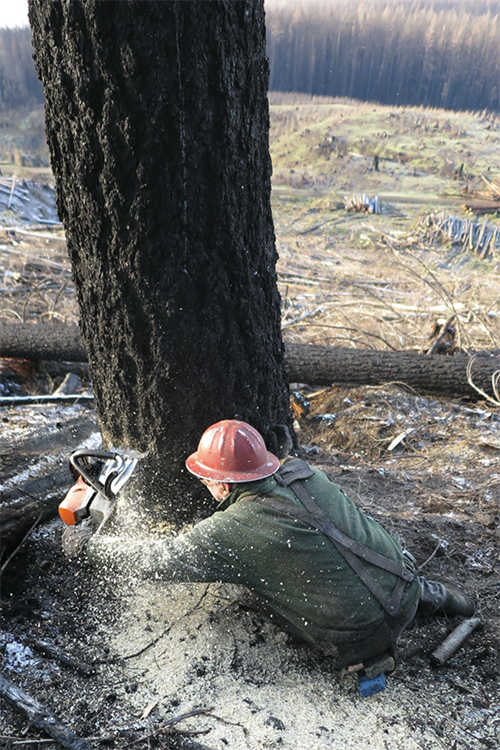
A feller cuts a dead Douglas-fir six months after the 2020 Beachie Creek Fire in Oregon. Photo by Steve Wilent.
